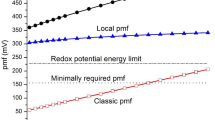Abstract
A central step in the metabolism of Desulfovibrio spp. is the oxidation of molecular hydrogen catalyzed by a periplasmic hydrogenase. However, this enzymatic activity is quite low at physiological pH. The hypothesis that, in the presence of the tetrahaem cytochrome c 3, hydrogenase can maintain full activity at physiological pH through the concerted capture of the resulting electrons and protons by the cytochrome was tested for the case of Desulfovibrio vulgaris (Hildenborough). The crucial step involves an electron-to-proton energy transduction, and is achieved through a network of cooperativities between redox and ionizable centers within the cytochrome (redox-Bohr effect). This mechanism, which requires a relocation of the proposed proton channel in the hydrogenase structure, is similar to that proposed for the transmembrane proton pumps, and is the first example which shows evidence of functional energy transduction in the absence of a membrane confinement.
Similar content being viewed by others
Author information
Authors and Affiliations
Additional information
Received: 2 April 1997 / Accepted: 23 May 1997
Rights and permissions
About this article
Cite this article
Louro, R., Catarino, T., LeGall, J. et al. Redox-Bohr effect in electron/proton energy transduction: cytochrome c 3 coupled to hydrogenase works as a 'proton thruster' in Desulfovibrio vulgaris . JBIC 2, 488–491 (1997). https://doi.org/10.1007/s007750050160
Issue Date:
DOI: https://doi.org/10.1007/s007750050160




